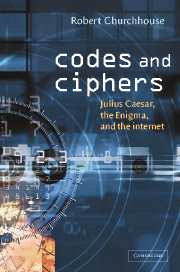Book contents
- Frontmatter
- Contents
- Preface
- 1 Introduction
- 2 From Julius Caesar to simple substitution
- 3 Polyalphabetic systems
- 4 Jigsaw ciphers
- 5 Two-letter ciphers
- 6 Codes
- 7 Ciphers for spies
- 8 Producing random numbers and letters
- 9 The Enigma cipher machine
- 10 The Hagelin cipher machine
- 11 Beyond the Enigma
- 12 Public key cryptography
- 13 Encipherment and the internet
- Appendix
- Solutions to problems
- References
- Name index
- Subject index
3 - Polyalphabetic systems
Published online by Cambridge University Press: 13 August 2009
- Frontmatter
- Contents
- Preface
- 1 Introduction
- 2 From Julius Caesar to simple substitution
- 3 Polyalphabetic systems
- 4 Jigsaw ciphers
- 5 Two-letter ciphers
- 6 Codes
- 7 Ciphers for spies
- 8 Producing random numbers and letters
- 9 The Enigma cipher machine
- 10 The Hagelin cipher machine
- 11 Beyond the Enigma
- 12 Public key cryptography
- 13 Encipherment and the internet
- Appendix
- Solutions to problems
- References
- Name index
- Subject index
Summary
Strengthening Julius Caesar: Vigenère ciphers
The weakness of the Julius Caesar system is that there are only 25 possible decrypts and so the cryptanalyst can try them all. Life can obviously be made more difficult for him if we increase the number of cases that must be tried before success can be assured. We can do this if, instead of shifting each letter by a fixed number of places in the alphabet, we shift the letters by a variable amount depending upon their position in the text. Of course there must be a rule for deciding the amount of the shift in each case otherwise even an authorised recipient won't be able to decrypt the message. A simple rule is to use several fixed shifts in sequence. For example, if instead of a fixed shift of 19 as was used in the message
COME AT ONCE
in the last chapter and which enciphered to
VHFX TM HGVX
we use two shifts, say 19 and 5, alternately, so that the first, third, fifth etc. letters are shifted 19 places and the second, fourth etc. are shifted 5 places then the cipher now becomes
VTFJ TY HSVJ.
If we replace the space character by Z in the message and use three shifts, say 19, 5 and 11, in sequence the plaintext becomes
COMEZATZONCE.
The cipher is now
VTXXELMEZGHP
and the key which provides the encipherment is 19–5–11.
- Type
- Chapter
- Information
- Codes and CiphersJulius Caesar, the Enigma, and the Internet, pp. 28 - 39Publisher: Cambridge University PressPrint publication year: 2001



